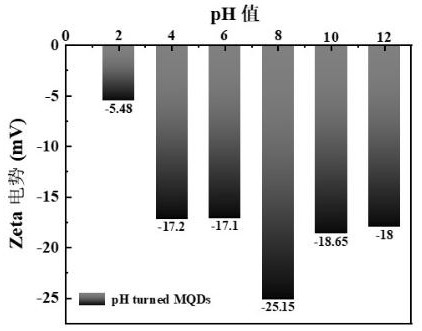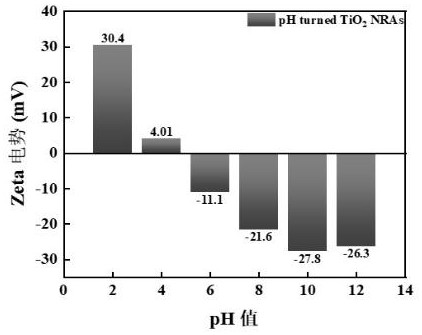Preparation and application of a one-dimensional titanium dioxide nanocomposite photoanode activated by mxene quantum dots
A nanocomposite and quantum dot technology, applied in photosensitive devices, photovoltaic power generation, electrolytic capacitors, etc., can solve the problems of reducing the recombination efficiency of photogenerated carriers and restricting high-efficiency applications, achieving strong electrostatic bonding, not easy to fall off, and improving stability. sexual effect
- Summary
- Abstract
- Description
- Claims
- Application Information
AI Technical Summary
Problems solved by technology
Method used
Image
Examples
Embodiment 1
[0041] One-dimensional TiO activated by MXene quantum dots 2 Preparation of nanocomposite photoanode:
[0042] Prepare a 50ml capacity polytetrafluoroethylene high-temperature reactor liner, add 15ml ultrapure water and 15ml concentrated hydrochloric acid to it, and stir for 5min at a rotational speed of 1000r / min. Then, 0.45 ml of tetrabutyl titanate was added dropwise to the inner pot, followed by stirring for 15 min, until the solution in the inner pot became clear. The cleaned FTO glass was slowly immersed in the above-prepared precursor solution leaning against the inner wall of the inner tank with the conductive surface facing down, and the inner tank was placed in a high-temperature stainless steel reaction kettle, and hydrothermally heated at 150 ° C for 12 hours. After the hydrothermal treatment is over, take out the FTO glass in the inner tank, rinse it several times with deionized water, and dry it with nitrogen. It can be found that a layer of white substance, nam...
Embodiment 2
[0047] One-dimensional TiO activated by MXene quantum dots with reference to Example 1 2 Preparation method of nanocomposite photoanode, obtained TiO 2 / (PDDA / MQDs) 6 Multilayer composite photoanode.
[0048] In order to prove that PDDA and MQDs have a synergistic effect on photoelectric performance as components in the composite photoanode, the two are indispensable. Therefore, as a comparison, PDDA alone and MXene quantum dots alone are also in the form of 6 layers. loaded onto TiO 2 On the nanorod substrate, a binary composite photoanode TiO was fabricated 2 / (PDDA) 6 and TiO 2 / (MQDs) 6 , and use the following methods to test.
[0049] Through the electrochemical workstation, and under simulated sunlight, the TiO 2 / (PDDA / MQDs) 6 , TiO 2 / (PDDA) 6 , TiO 2 / (MQDs) 6 and pure TiO 2 These four photoanode samples were subjected to IPCE testing, and TiO 2 / (PDDA / MQDs) 6 It has the largest incident photon-current conversion efficiency, up to 16%.
PUM
| Property | Measurement | Unit |
|---|---|---|
| particle size | aaaaa | aaaaa |
Abstract
Description
Claims
Application Information
 Login to View More
Login to View More - R&D
- Intellectual Property
- Life Sciences
- Materials
- Tech Scout
- Unparalleled Data Quality
- Higher Quality Content
- 60% Fewer Hallucinations
Browse by: Latest US Patents, China's latest patents, Technical Efficacy Thesaurus, Application Domain, Technology Topic, Popular Technical Reports.
© 2025 PatSnap. All rights reserved.Legal|Privacy policy|Modern Slavery Act Transparency Statement|Sitemap|About US| Contact US: help@patsnap.com



